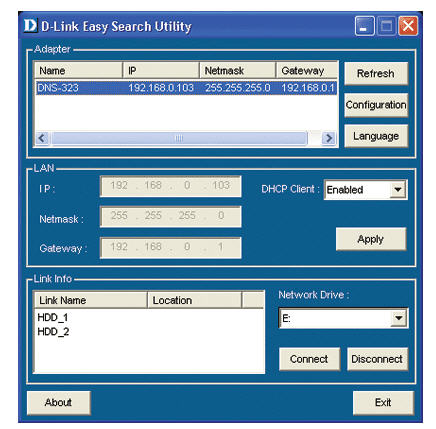D-Link DNS-323 How To Install On LMCE-810
From LinuxMCE
How to Install D-Link DNS-323 on LinuxMCE-810
[D-Link DNS-323 Official Site]
The following instructions assume you’re using LinuxMCE version 8.10
Preparing the DNS-323
I recommend to setup the NAS first on your external network then move it to the internal LinuxMCE network.
- Please follow manufacturer instruction for installing the SATA HDD.
- Connect the NAS to you external network
- Check the external router DHCP server for the NAS IP address, or use the utility that came with the NAS “D-Link Easy Search Utility” to locate the IP address
- Log in to the NAS using any web browser on the external network by setting the URL to: http://NAS-IPaddress
- Default “admin” password is “Blank, Nothing”, after log in, change admin default password (recommended), from “Tools/Admin Password”
- Select suitable RAID level for your application and format the drives
- Check NAS firmware version, it should have 1.07, from “Tools/Firmware” if not; follow manufacturer instruction to update the firmware
- You should see “Volume_1” as a share directory, from “Advanced/Network access”
- Add new user with password to the NAS, using “Advanced/Users-Group”
- Remove default user “ALL” for the “Volume_1” share, and add the user you just created.
- Set “Oplocks & Map archive” of the “Volume_1” share to “Yes”
- From “Setup/Device” change workgroup to “linuxmce”
- Make sure all other services/servers are off or disabled (FTP, UPnP AV, iTunes, DHCP, LLTD)
- Power down the NAS & disconnect the Ethernet cable
- Done with NAS preparation
Preparing the LinuxMCE
- On the Core edit “/etc/samba/smb.conf” with your favorite editor
- Add the following line to the end of the [global] section
client lanman auth = yes
Example:
[global]
## BEGIN : Domain and Hostname
workgroup = LinuxMCE
server string = DCERouter
netbios name = DCERouter
## END : Domain and Hostname
smb ports = 139
log level = 2
invalid users = root
log file = /var/log/samba/log.%m
max log size = 1000
syslog = 0
encrypt passwords = true
socket options = TCP_NODELAY
dns proxy = no
passwd program = /usr/bin/passwd %u
passwd chat = *Enter\snew\sUNIX\spassword:* %n\n *Retype\snew\sUNIX\spassword:* %n\n .
username map = /etc/samba/usermap.txt
unix extensions = yes
security = user
client lanman auth = yes
[public]
- Save and quit
- Repeat step 2 to all the MDs in the house
- Now you can reboot the Core or run as (sudo or root)
service samba restart
- Done with LinuxMCE preparation
DNS-323 Installation
- Connect the NAS to the internal network
- Power up the NAS
- Wait couple minutes, LinuxMCE will detect it
- LinuxMCE will ask if you want to use the DNS-323 as a “File server”, select “File Server”
- Select location “Room”
- LinuxMCE will install needed SW
- LinuxMCE will ask to use reload the router, select “OK”, Don’t “reload” yet.
- LinuxMCE will ask to use DNS-323/web_page as Windows share, select “No, and ignore it every time. Don’t ask again for this device”
- LinuxMCE will ask to use DNS-323/ Volume_1 as Windows share, select “Yes”
- LinuxMCE will ask “Regarding your new storage device, can it be used automatically for storing media, such as TV shows and music” select “YES”, or “ use it only when specifically told to”
- LinuxMCE asks how to use the directory structure select “YES”, use LinuxMCE’s directory structure”
- LinuxMCE will ask you for username & Password, enter the ones you created above.
- After it is done, reload router
- LinuxMCE will ask to regenerate all orbiters in the house select “YES”
- Now you can copy or move all your media files to the NAS
- From the WebAdmin /Files & Media/Media Files Sync/ select Data folder on the left side and click “Resynchronize” wait until it is done
- Now you should see your media on your Core and all your MDs
- Done with the installation
- Cheers {[Beer]
Troubleshooting
If you screwed up something with the above procedure, and you decided to start all over again, then follow the instruction below to remove the NAS from the PnpQueue, and reinstall it again:
- Power down the NAS
- Log in to the Mysql database "sudo mysql -uroot"
- Select the table from the database "use pluto_main"
- View all the devices in the queue, and locate the IP address of the NAS "SELECT * FROM PnpQueue;"
- View all rows of the NAS to be sure, you should see at lease 2 rows "SELECT * FROM PnpQueue where IPaddress=’192.168.80.xxx’;"
- Delete all rows related to the above IP address " DELETE FROM PnpQueue WHERE IPaddress=’192.168.80.xxx’;"
- Quit Mysql "quit"
- Reload the router
- Turn ON the device
- Now LinuxMCE will detect the device automatically "PnP"
- Done
External References
[http://benchmarkreviews.com/index.php?option=com_content&task=view&id=58&Itemid=70&limit=1&limitstart=0 D-Link DNS-323 Benchmark ]


